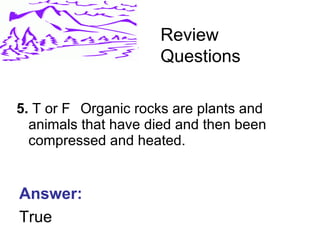Unit 1 test review
- 1. 6 th Grade Science Unit 1 Common Assessment Review Questions
- 2. T or F Listen to or read instructions carefully before attempting to do anything. Review Questions Answer: True
- 3. 2. Tor F Clean up broken glass around your work station before you notify the teacher. Review Questions Answer: False
- 4. 3. Tor F Safety goggles should be worn during lab to protect your eyes from hot liquids or hazardous chemicals Review Questions Answer: True
- 5. 4. Tor F Gems are rare minerals that can be cut and polished. Review Questions Answer: True
- 6. 5. T or F Organic rocks are plants and animals that have died and then been compressed and heated. Review Questions Answer: True
- 7. 6. ____ is a process of understanding the world. a. Science c. A control b. Technology d. A constant Review Questions Answer: Science
- 8. 7. A testable prediction about a possible solution to a problem is called ____. a. a conclusion c. a hypothesis b. an experiment d. a variable Review Questions Answer: A hypothesis
- 9. 8. When designing an experiment, the first step is to ____. a. analyzing the data c. state a hypothesis b. list a procedure d. state the problem Review Questions Answer: state the problem
- 10. 9. The study of the cultural remains of ancient people is ____. a. technology c. a control b. a hypothesis d. archaeology Review Questions Answer: archaeology
- 11. 10. Computers, cameras, and radar are examples of ____. a. constants c. technology b. variables d. experiments Review Questions Answer: technology
- 12. 11. Recognizing a problem, making observations, forming and then testing a hypothesis, and analyzing data are all steps in ____. a. an experiment c. a scientific method b. technology d. an inference Review Questions Answer: a scientific method
- 13. 12. Rocks are produced when magma or lava cools and hardens are called _____? a. igneous rocks c. sedimentary rocks b. metamorphic rocks d. all of the above Review Questions Answer: igneous rocks
- 14. 13. What is rock made of? a. Sedimentary rock that is heated b. eroded to form metamorphic rock c. Extrusive and Intrusive rock d. Two or more minerals Review Questions Answer: Two or more minerals
- 15. 14. Minerals form from ______. a. volcanic activity b. evaporation, precipitation, and lava c. sedimentary rock d. igneous rock Review Questions Answer: evaporation, precipitation, and lava
- 16. 15. What is a mineral? a. Inorganic natural substance b. Organic natural substance c. A substance 4.0 or more hardness d. An extrusive substance Review Questions Answer: Inorganic natural substance
- 17. 16. What kind of rocks are formed by volcanic eruptions? a. detrital c. organic b. foliated d. extrusive Review Questions Answer: extrusive
- 18. 17. A model that shows the process of how rocks are changed from one type to another. a. ore c. rock cycle b. crystal d. extrusive rock Review Questions Answer: rock cycle
- 19. 18. A mineral that contains something (usually metal) that can be useful and sold for a profit a. ore c. rock b. crystal d. gem Review Questions Answer: ore
- 20. 19. What causes each type of rock in the rock cycle to turn into sediments? a. magma b. heat and pressure c. weathering and erosion d. igneous rock Review Questions Answer: weathering and erosion
- 21. 20. What are bowl shaped basins resulting from glacial erosion on the side of a mountain a. Moraines c. Cirques b. Hornes d. Striations Review Questions Answer: Cirques
- 22. 21. Trees that grow up straight but have a bent trunk near their base show signs of a. rockfalls c. creep b. mud flow d. slump Review Questions Answer: creep
- 23. 22. To reduce erosion of steep slopes, people can ____________. a. plant vegetation c. build walls b. insert drainage d. all of the above Review Questions Answer: all of the above
- 24. 23. Which term refers to sediment that is deposited by meltwater most often beyond the end of a glacier? a. loess c. outwash b. moraine d. till Review Questions Answer: outwash
- 25. 24. The picture above is a picture of a. slump c. mudflow b. abrasion d. loess Review Questions Answer: slump
- 26. 25. In the picture above letter “B” is pointing to a. arete c. hanging valley b. cirque d. horn Review Questions Answer: horn
- 27. 26. A process that wears away surface materials and moves them from one place to another a. erosion c. deflation b. deposition d. abrasion Review Questions Answer: erosion
- 28. 27. The dropping of sediments a. erosion c. deflation b. deposition d. abrasion Review Questions Answer: deposition
- 29. 28. _____ is the result of wind blowing across loose sediment, removing small particles and leaving heavier material behind. a. Erosion c. Deflation b. Deposition d. Abrasion Review Questions Answer: Deflation
- 30. 29. The polishing and pitting of rocks by windblown particles. a. erosion c. deflation b. deposition d. abrasion Review Questions Answer: abrasion
- 31. 30. What are 3 properties of minerals? 1. _________ 2.__________ 3.__________ Review Questions Answer: hardness, luster, streak, color, taste, fracture, cleavage, crystal, specific gravity, fluorescence, smell






























